
 "Hades" "Hades"
from Dream & the Underworld
by Dr. James Hillman
Harper Books ©1979 and used with permission
Hades was of course the God of depths, the God of invisibles. He is himself invisible, which could imply that the invisible connection is Hades, and that the essential "what" that holds things in their form is the secret of their death. And if, as Heraclitus said, Nature loves to hide, then nature loves Hades.
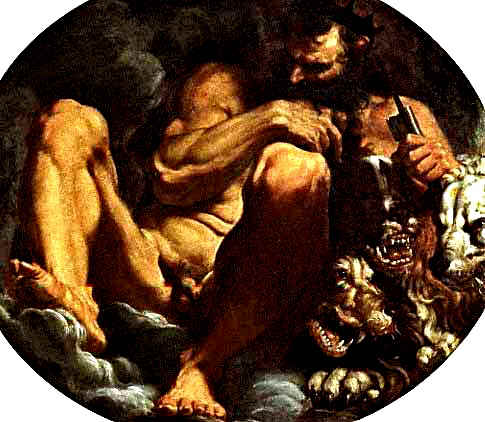
Hades is said to have had no temples or altars in the upperworld and his confrontation with it is experienced as a violence, a violation (Persephone's rape; the assaults on simple vegetative nymphs, Leuce and Minthe; and Iliad 5, 395 or Pindar Ol. 9, 33). He is so invisible in fact that the entire collection of Greek antique art shows no ideal portrait of Hades, such as we are familiar with of other Gods. He had no representative attributes, except an eagle, which brings out his shadowy affiliation with his brother, Zeus. He leaves no trace on earth, for no clan descends from him, no generations.
Hades' name was rarely used. At times he was referred to as "the unseen one," more often as Pluto ("wealth," "riches") or as Trophonios ("nourishing"). These disguises of Hades have been taken by some interpreters to be covering euphemisms for the fear of death, but then why this particular euphemism and not some other? Perhaps Pluto is a description of Hades, much as Plato understood this God. Then, Pluto refers to the hidden wealth or the riches of the invisible. Hence, we can understand one reason why there was no cult and no sacrifice to him-Hades was the wealthy one, the giver of nourishment to the soul. Sometimes, he was fused with Thanatos ("Death) of whom Aeschylus wrote, "Death is the only God who loves not gifts and cares not for sacrifices or libation, who has no altars and receives no hymns..." (frg. Niobe). 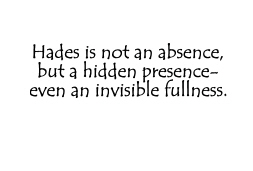 On vase paintings when Hades is shown, he may have his face averted, as if he were not even characterized by a specific physiognomy. All this 'negative' evidence does coalesce to form a definite image of a void, an interiority or depth that is unknown but nameable, there and felt even if not seen. Hades is not an absence, but a hidden presence-even an invisible fullness. On vase paintings when Hades is shown, he may have his face averted, as if he were not even characterized by a specific physiognomy. All this 'negative' evidence does coalesce to form a definite image of a void, an interiority or depth that is unknown but nameable, there and felt even if not seen. Hades is not an absence, but a hidden presence-even an invisible fullness.
Etymological investigations into the root word for death demon show it to mean "hider." To grasp better the ways in which Hades hides invisibly in things, let us take apart this concept, listening for the hidden connections, the metaphors, within the word hidden itself: (1) buried, shrouded, concealed from eyesight, whether a corpse or a mysterium: (2) occult, esoteric, concealed in the sense of secret; (3) that which per se cannot be seen: non-visible as non-spatial, non-extended; (4) without light: dark, black; (5) that which cannot be seen on inspection; i.e. blocked, censored, forbidden, or obscured; (6) hidden, as contained within (interior) or as contained below (inferior), where the Latin cella ("subterranean storeroom") is cognate with the Old Irish cuile ("cellar") and cel ("death"), again cognate with our hell; (7) that which is experienced with dread and terror, a void, a nothing; (8) that which is experienced as hiding, e.g., withdrawing, turning away from life; (9) stealth, surreptitiousness, deceit, such as the 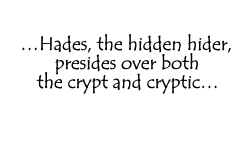 hidden motives and unseen connections of Hermes. In short, Hades, the hidden hider, presides over both the crypt and cryptic, which gives to Heraclitus' phrase (frg. 123): "Nature loves to hide" (physis kryptesthai philei), a subtle and multiple-implication indeed. hidden motives and unseen connections of Hermes. In short, Hades, the hidden hider, presides over both the crypt and cryptic, which gives to Heraclitus' phrase (frg. 123): "Nature loves to hide" (physis kryptesthai philei), a subtle and multiple-implication indeed.
Some say that the cap or helmet Hades wears belongs primarily to Hermes and may have little or nothing to do with Hades. This hat is a curious phenomenon: Hermes wears it, Hades wears it: Athene puts it on to beat Ares, and Perseus to overcome the Gorgon. It makes its wearer invisible. Evidently the explicit image of connection between Hermes and Hades (announced in the Homeric "Hymn to Hermes") is the headdress. Hermes and Hades share a certain style of covering their heads that both hides their thoughts and perceives hidden thoughts. It is their intentions that become invisible. We cannot perceive where their 'heads are at,' though we may have the sense of a hidden watch over inmost thoughts. Because we can never discover what their covert minds intend, we consider them deceptive, unpredictable, frightening—or wise.
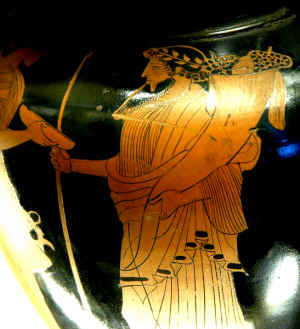
When we consider the House of Hades, we must remember that the myths—and Freud, too—tell us that there is no time in the underworld. There is no decay, no progress, no change of any sort. Because time has nothing to do with the underworld, we may not conceive the underworld as "after" life, except as the afterthoughts within life. The House of Hades is a psychological realm now, not an eschatological realm later. It is not a far-off place of judgment over our actions but provides that place of judging now, and within, the inhibiting reflection interior to our actions.
This simultaneity of the underworld with the daily world is imaged by Hades, coinciding indistinguishably with Zeus, or identical with Zeus chthonios. The brother hood of Zeus and Hades says that upper and lower worlds are the same; only the perspectives differ. There is only one and the same universe, coexistent and synchronous, but one brother's view sees it from above and through the light, the other from below and into its darkness. Hades' realm is contiguous with life, touching it at all points, just below it, its shadow brother (Doppelganger) giving to life its depth and its psyche.
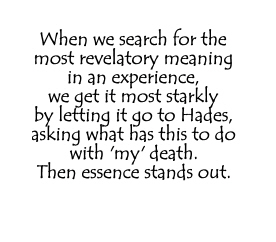
Because his realm was conceived as the final end of each soul, Hades is the final cause, the purpose, the very telos of every soul and every soul process. If so, then all psychic events have a Hades aspect, and not merely the sadistic or destructive events that Freud attributed to Thanatos. All soul processes, everything in the psyche, moves towards Hades. As the finis is Hades, so the telos is Hades. Everything would become deeper, moving from the visible connections to the invisible ones, dying out of life. When we search for the most revelatory meaning in an experience, we get it most starkly by letting it go to Hades, asking what has this to do with 'my' death. Then essence stands out.
Here too Hades has bearing on psychological theory. A psychology that emphasizes the final point of view—Jung's, for instance, and Adler's—is restating the Hades perspective, even if these psychologies do not go right to the end of their ends. I mean by this the finalism of psychology seems to shy away from the full consequences of mythology, in which the finalism is not a theory only but is the experience in soul of its call to Hades.
Now hold here a moment. Let us beware of taking this call as literal death, of which so much is spoken and written today, that we begin to believe we know all about what we know nothing about. Literal death is becoming a clichéd mystery, that is, we have best-seller evidence about the unknowable.
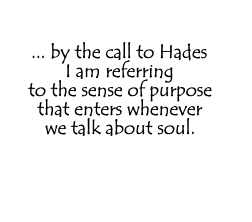 Rather, by the call to Hades I am referring to the sense of purpose that enters whenever we talk about soul. What does it want? What is it trying to say (in this dream, this symptom, experience, problem)? Where is my fate or individuation process going? If we stare these questions in the face, of course we know where our individuation process is going-to death. This unknowable goal is the one absolutely sure event of the human condition. Hades is the unseen one and yet absolutely present. Rather, by the call to Hades I am referring to the sense of purpose that enters whenever we talk about soul. What does it want? What is it trying to say (in this dream, this symptom, experience, problem)? Where is my fate or individuation process going? If we stare these questions in the face, of course we know where our individuation process is going-to death. This unknowable goal is the one absolutely sure event of the human condition. Hades is the unseen one and yet absolutely present.
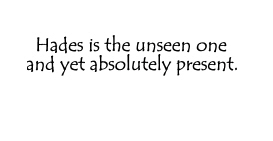 The call to Hades suggests that all aspects of the process of the soul must be read finally, not only as part of the general human process toward death, but as particular events of and in that death. Each facet then is a finished image in itself, completing its purpose that is at the same time unending, not literally unending in time but limitless in depth. In other words, we can stop nowhere—and anywhere—because the end is not in time but in death, where death means the telos or fulfillment of anything, or, we can stop anywhere, because from the final point of view everything is an end in itself. The goal is always now. The call to Hades suggests that all aspects of the process of the soul must be read finally, not only as part of the general human process toward death, but as particular events of and in that death. Each facet then is a finished image in itself, completing its purpose that is at the same time unending, not literally unending in time but limitless in depth. In other words, we can stop nowhere—and anywhere—because the end is not in time but in death, where death means the telos or fulfillment of anything, or, we can stop anywhere, because from the final point of view everything is an end in itself. The goal is always now.
A true finalistic psychology will show its ends in its means. We will be able to see its end goal of death in the methods it uses to work towards it. Therefore, to live fully into the consequences of the finalistic view means to be the perspective of Hades and the underworld toward each psychic event. We ask: what is the purpose of this event for my soul, for my death? Such questions extend the dimension of depth without limit, and again psychology is pushed by Hades into an imperialism of soul, reflecting the imperialisms of his kingdom and the radical dominion of death.
More info on Hades and the underworld
Dream & the Underworld
Return to Passages Menu
Subscribe to the Passages e-newsletter
|

